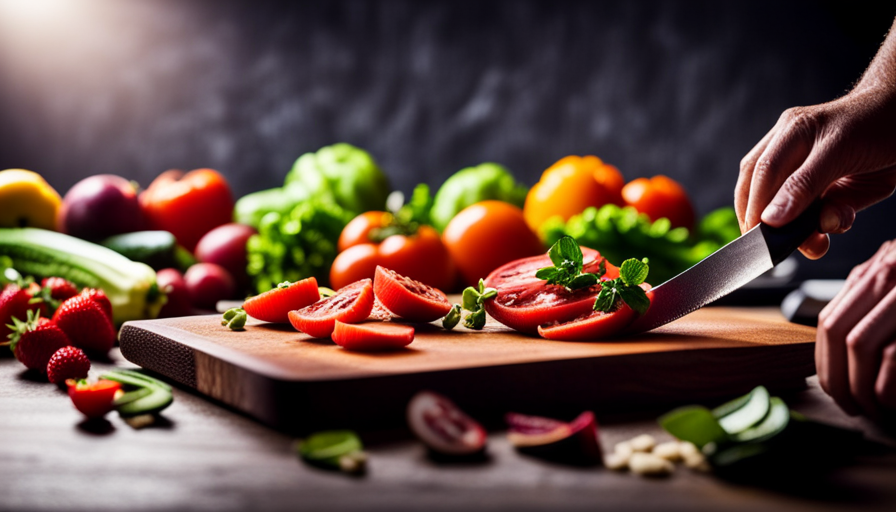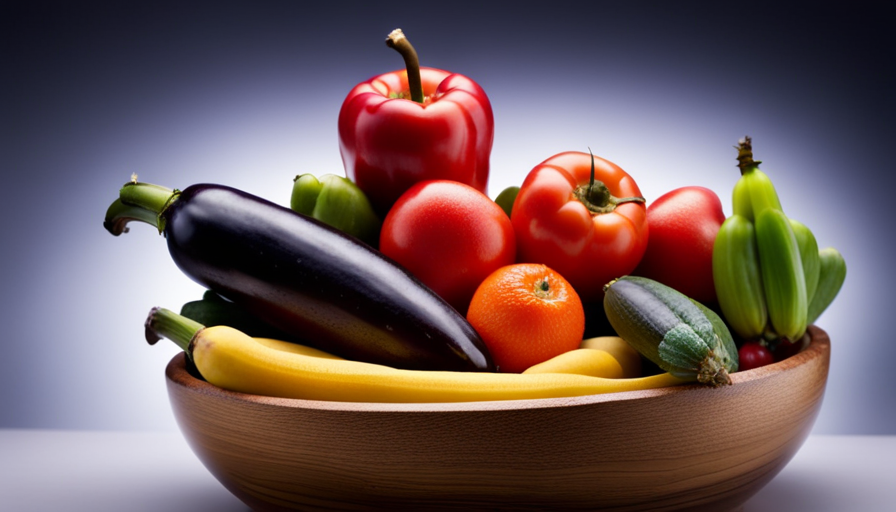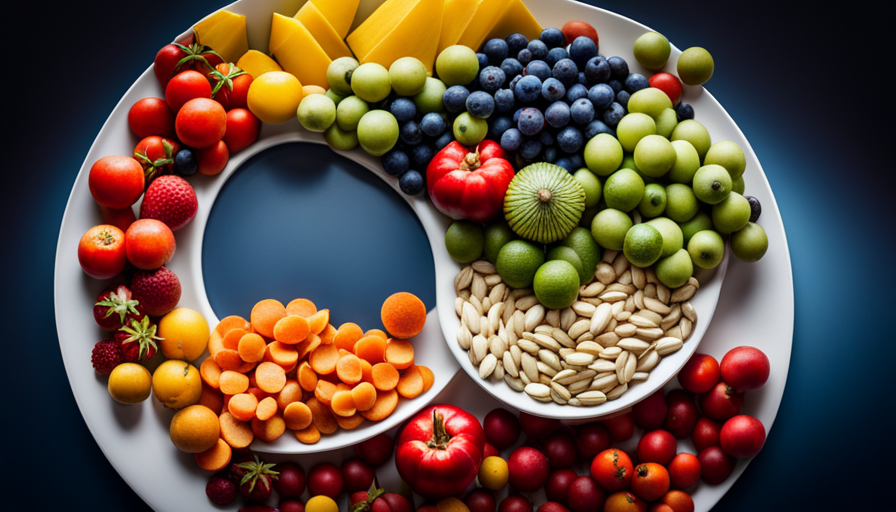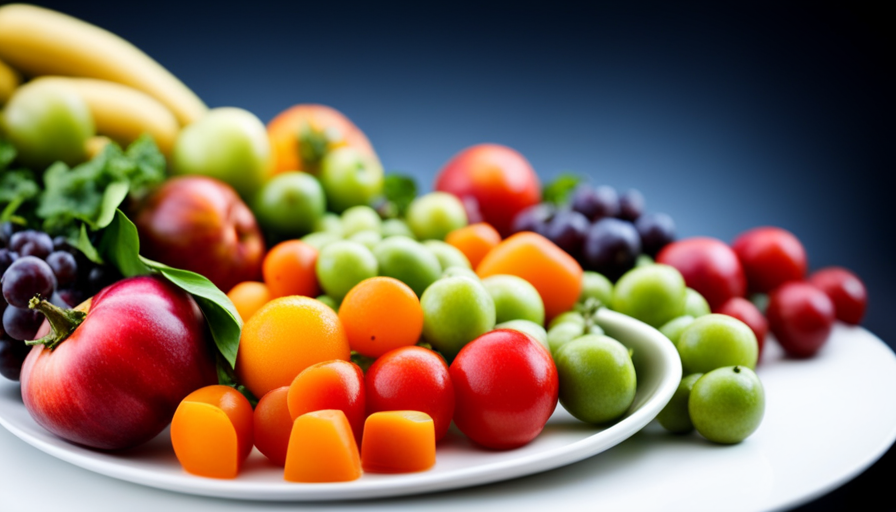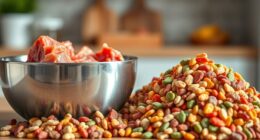Do you feel weary of consuming processed foods all the time, but do not possess a high-tech food processor to create tasty raw meals? No need to worry! You can still experience the advantages of a raw diet without the need for a fancy gadget.
In fact, you can eat raw without a food processor and still create mouthwatering dishes that are packed with nutrients. By utilizing simple cutting techniques, mashing and smashing for texture, and using a blender for smooth recipes, you can easily incorporate raw foods into your diet.
Chopping and dicing for salads and salsas, soaking and sprouting for enhanced nutrients, and making raw energy bars and bliss balls are all simple ways to add variety to your raw meals. And let’s not forget about raw soups, gazpachos, and desserts that will satisfy your cravings.
So, put away that food processor and get ready to discover a whole new world of delicious, nutritious, and raw culinary delights!
Key Takeaways
- Raw food can be enjoyed without a food processor.
- Simple cutting techniques like chopping and dicing can be used for salads and salsas.
- Soaking and sprouting can enhance the nutrients in raw meals.
- Blenders can be used as an alternative to a food processor for creating smooth and creamy textures in raw dishes.
Exploring Raw Food Options
Now that you’ve decided to explore raw food options, let’s dive into the world of eating raw without a food processor! Exploring raw food preparation techniques is an exciting way to incorporate raw food into your daily meals. Don’t worry if you don’t have a food processor because there are plenty of other tools you can use to achieve the same results.
One of the easiest ways to prepare raw food without a food processor is by using a blender. A high-powered blender can chop, blend, and puree ingredients just like a food processor. It’s perfect for making smoothies, soups, and sauces. If you don’t have a blender, a good old-fashioned knife and cutting board can work wonders. Chopping your ingredients into small, uniform pieces will help enhance the flavors and textures of your raw dishes.
Another handy tool to have in your raw food arsenal is a mandoline slicer. This nifty gadget allows you to slice fruits and vegetables into thin, even pieces. It’s great for making salads, wraps, and even raw pasta dishes. If you don’t have a mandoline slicer, a vegetable peeler can also do the trick. Simply peel your veggies into thin strips to achieve a similar effect.
So, don’t let the absence of a food processor hold you back from exploring the world of raw food. With a blender, knife, cutting board, mandoline slicer, or vegetable peeler, you can easily incorporate raw food into your daily meals and enjoy all the health benefits it has to offer.
Utilizing Simple Cutting Techniques
Utilizing basic cutting techniques, you can effortlessly transform fresh ingredients into a culinary masterpiece. When it comes to eating raw without a food processor, simple slicing and honing your knife skills are essential. Here’s how you can make the most of these techniques.
-
Delicate Ribbons: Slice vegetables like zucchini or cucumber into thin, delicate ribbons using a sharp knife. These ribbons can be used as a base for salads or wrapped around fillings for a refreshing appetizer. The thin slices allow the flavors to meld together harmoniously.
-
Julienne Strips: Transform your vegetables into julienne strips by cutting them into long, thin matchstick-like pieces. This technique works well with carrots, bell peppers, and even fruits like apples. Julienne strips add a satisfying crunch and visual appeal to your raw dishes.
-
Precision Chopping: Master the art of precision chopping by cutting your ingredients into uniformly sized pieces. This technique is ideal for creating salsas, relishes, or even raw soups. Uniformly sized pieces ensure even distribution of flavors and a consistent texture in every bite.
By honing your simple slicing and knife skills, you can elevate your raw dishes to a whole new level. With just a knife and some fresh ingredients, the possibilities are endless. So grab your knife and let your creativity flow in the kitchen!
Mashing and Smashing for Texture
Mastering the art of mashing and smashing is the key to achieving the perfect texture in your culinary creations. When it comes to eating raw without a food processor, there are various mashing techniques and alternative tools you can use to get the job done.
One simple mashing technique is to use a fork. This allows you to easily mash and smash fruits like bananas or avocados. Simply place the fruit on a plate or in a bowl and use the fork to mash it until you reach your desired consistency. Another option is to use a potato masher, which can be used for larger fruits and vegetables like sweet potatoes or carrots.
If you’re looking for a smoother texture, consider using a mortar and pestle. This traditional tool allows you to grind and mash ingredients together, creating a paste-like consistency. It works well for herbs, spices, and even nuts.
Lastly, if you don’t have any of these tools on hand, you can always use a blender bottle. Simply place your ingredients inside, seal the lid tightly, and shake vigorously until everything is mashed together. This is a great option for when you’re on the go or don’t have access to traditional mashing tools.
By mastering these mashing techniques and utilizing alternative tools, you can create delicious raw dishes without the need for a food processor.
| Mashing Techniques | Alternative Tools |
|---|---|
| Fork | Potato Masher |
| Mortar and Pestle | Blender Bottle |
Using a Blender for Smooth Recipes
If you’re craving a velvety smooth texture in your culinary creations, grab your blender and get ready to whip up some deliciously creamy recipes.
Blenders are a fantastic tool for creating smooth raw dishes without the need for a food processor. Not only can blenders achieve a silky texture, but they also have some clever hacks and can even act as an alternative appliance in certain situations.
One blender hack is to use frozen fruit instead of ice cubes. This not only adds flavor to your smooth recipes but also creates a thick and creamy consistency.
Another tip is to blend your ingredients in stages. Start with the harder ingredients like nuts or seeds, then gradually add in the softer ones like fruits or vegetables. This will ensure a smooth and even blend.
Blenders can also serve as an alternative appliance for making sauces and dressings. Simply blend together your desired ingredients until smooth and creamy. You can also use a blender to make nut milk by blending soaked nuts with water and then straining the mixture.
So, if you don’t have a food processor on hand, or if you’re looking for a quick and easy way to achieve a smooth texture in your raw dishes, turn to your blender. With these blender hacks and alternative uses, you’ll be able to create velvety smooth recipes in no time.
Chopping and Dicing for Salads and Salsas
To achieve a burst of flavor and vibrant texture in your salads and salsas, simply whip out your trusty knife and start chopping and dicing your ingredients. Chopping techniques play a crucial role in creating delicious and visually appealing dishes.
When it comes to salads, it’s important to chop your vegetables into bite-sized pieces that are easy to eat. Start by washing and drying your vegetables thoroughly. Then, remove any tough stems or leaves and cut them into strips. For harder vegetables like carrots or cucumbers, it’s best to cut them into thin slices or dice them into small cubes. This will ensure that each bite is evenly balanced and full of flavor.
When making salsa, chopping techniques are equally important. For a chunkier salsa, chop your ingredients into larger pieces. Start by removing the seeds and membranes from your tomatoes and peppers. Then, chop them into small cubes. For a smoother salsa, finely chop your ingredients or use a food processor. Remember to incorporate a variety of flavors and textures by adding onions, garlic, cilantro, and lime juice. Mix everything together and let it sit for a while to allow the flavors to meld together.
By mastering the art of chopping and dicing, you’ll be able to create salads and salsas that are bursting with flavor and have the perfect texture. So grab your knife and get chopping, and let your creativity shine through in your delicious and refreshing dishes.
Marinating and Pickling for Flavor
By honing your skills in marinating and pickling techniques, you can elevate the flavors of your dishes and add a touch of sophistication. Marinating is a great way to infuse your raw dishes with bold and complex flavors. Here are four marinating techniques to try:
-
Citrus Marinade: Combine freshly squeezed citrus juice, such as lemon or lime, with a splash of olive oil, minced garlic, and your choice of herbs and spices. Let your ingredients marinate for at least 30 minutes to allow the flavors to meld together.
-
Soy Sauce Marinade: Mix soy sauce, minced ginger, garlic, and a touch of honey or maple syrup for sweetness. This marinade is perfect for adding an umami flavor to your raw dishes.
-
Herb Marinade: Combine chopped fresh herbs like basil, cilantro, or parsley with olive oil, minced garlic, and a squeeze of lemon juice. Let your ingredients marinate for at least an hour to infuse the flavors into your raw ingredients.
-
Spicy Marinade: Create a spicy marinade by combining minced chili peppers, lime juice, olive oil, and a pinch of salt. This marinade will add a kick to your raw dishes.
Pickling is another technique that can add depth and tanginess to your raw dishes. Here are two pickling recipes to try:
-
Quick Pickled Vegetables: Thinly slice your choice of vegetables, such as cucumbers, carrots, or radishes. In a jar, combine equal parts vinegar, water, and sugar, along with a pinch of salt. Pour the pickling liquid over the vegetables and let them sit for at least 30 minutes before enjoying.
-
Pickled Onions: Thinly slice red onions and place them in a jar. In a separate bowl, mix together apple cider vinegar, sugar, and salt until the sugar and salt dissolve. Pour the mixture over the onions and let them pickle in the fridge for at least an hour before using.
By incorporating these marinating techniques and pickling recipes into your raw food preparations, you can enhance the flavors and bring a new dimension to your dishes. Get creative and experiment with different flavors to find your favorites.
Soaking and Sprouting for Enhanced Nutrients
Transform your dishes into vibrant and nutrient-rich creations by embracing the transformative power of soaking and sprouting. Sprouting is a process that involves germinating seeds, nuts, or grains to unlock their full potential. By sprouting, you activate enzymes that enhance the nutritional value and digestibility of these foods.
The benefits of sprouting are numerous. It increases the availability of vitamins, minerals, and antioxidants while reducing the levels of anti-nutrients and enzyme inhibitors present in raw foods.
To start sprouting, choose organic seeds, nuts, or grains and rinse them thoroughly. Soak them in filtered water for the recommended time, which varies depending on the type of food. For example, legumes like chickpeas or lentils may require 8-12 hours, while nuts and seeds usually need 4-6 hours. After soaking, drain the water and rinse again.
Transfer the soaked food into a sprouting container or a clean jar covered with a breathable cloth. Place it in a warm, dark spot and rinse the food twice a day. Within a few days, you will notice tiny sprouts emerging. Rinse them one last time before consuming.
Incorporating sprouts into your raw dishes not only adds a pleasant crunch but also boosts their nutritional profile. Soaking and sprouting are simple techniques that can take your raw meals to the next level, providing you with a wealth of nutrients and a burst of flavor.
Making Raw Energy Bars and Bliss Balls
Now that you know all about soaking and sprouting to enhance the nutrients in your raw foods, let’s move on to another exciting aspect of raw eating: making raw energy bars and bliss balls.
These delicious and nutritious treats are perfect for when you need a quick burst of energy or a satisfying snack on the go.
Raw energy bars and bliss balls are fantastic because they require no baking and can be made easily without a food processor. All you need is a sturdy blender or a good old-fashioned mixing bowl and a bit of elbow grease.
Simply combine your favorite raw ingredients like nuts, seeds, dates, and dried fruits in a blender or bowl, and then use your hands to shape them into bite-sized balls or bars. You can get creative with your flavors by adding ingredients like cacao powder, coconut flakes, or even a pinch of cinnamon.
Once you’ve formed your raw energy balls or bars, simply pop them in the fridge or freezer for a couple of hours to firm up. Then, you’ll have a batch of tasty, nutritious, and satisfying snacks ready to enjoy whenever hunger strikes.
So, get creative and start making your own raw energy balls and bliss balls today. Your taste buds and your body will thank you!
Creating Raw Soups and Gazpachos
Get ready to indulge in the refreshing and revitalizing experience of creating your own delectable raw soups and gazpachos. It’s a burst of vibrant flavors that’ll leave you feeling rejuvenated and invigorated.
With just a few simple ingredients and some creativity, you can whip up these nutritious and delicious dishes in no time. Here are some ideas to get you started:
-
Creating raw smoothies: Blend together a combination of fresh fruits and vegetables, like strawberries, bananas, spinach, and kale, with a splash of coconut water or almond milk. Experiment with different flavor combinations to find your favorite.
-
Experimenting with raw dips: Take your raw veggies to the next level by pairing them with a variety of homemade raw dips. Try blending together avocado, lime juice, cilantro, and garlic for a creamy and flavorful guacamole. Or mix together cashews, nutritional yeast, and lemon juice for a cheesy and tangy vegan cheese dip.
-
Adding herbs and spices: Don’t be afraid to get creative with your seasonings. Fresh herbs like basil, mint, and parsley can add a burst of freshness to your soups and gazpachos. Spices like cumin, paprika, and turmeric can add depth and complexity to your flavors.
-
Garnishing with toppings: Don’t forget to add some extra texture and flavor to your soups and gazpachos with some tasty toppings. Sprinkle on some chopped nuts, seeds, or diced vegetables for added crunch and visual appeal.
With these tips and ideas, you’ll be well on your way to creating delicious and nutritious raw soups and gazpachos. So grab your blender and get ready to enjoy a refreshing and satisfying meal that’ll nourish your body and delight your taste buds.
Discovering Raw Desserts and Treats
Are you ready to satisfy your sweet tooth with delectable raw desserts and treats that’ll leave you craving for more?
When it comes to raw food, desserts may not be the first thing that comes to mind, but you’ll be surprised by the variety of delicious options available. Raw dessert recipes aren’t just tasty but also packed with nutrients, making them a guilt-free indulgence.
One of the benefits of raw food is that it retains all the nutrients and enzymes that can be destroyed through cooking. By using raw ingredients in your desserts, you can ensure that you’re getting the maximum nutritional value from your sweet treats. Raw desserts are also free from refined sugars and unhealthy fats, making them a healthier alternative to traditional desserts.
To create raw desserts and treats without a food processor, you can use a blender or a good old-fashioned mixing bowl and some elbow grease. Many raw dessert recipes require simple ingredients like nuts, dates, coconut oil, and cacao powder. These ingredients can be easily mixed and blended to create delicious desserts like raw chocolate mousse, nut-based truffles, and creamy fruit tarts.
So, don’t let the absence of a food processor stop you from enjoying raw desserts and treats. With a little creativity and the right ingredients, you can whip up a range of delectable and nutritious sweets that’ll leave you satisfied and craving for more.
Frequently Asked Questions
Can I eat raw food without a food processor?
Yes, you can definitely achieve raw food textures without using a food processor. There are various raw food preparation techniques that you can try. For example, you can use a grater to shred vegetables, a mandoline slicer to make thin slices, or a sharp knife to chop ingredients finely. By using these tools and techniques, you can create the desired textures for your raw food dishes even without a food processor.
How can I achieve different textures in raw food without a food processor?
To achieve different textures in raw food without a food processor, you can try using other kitchen tools like a blender or a grater. For a creamy texture, use a blender to puree ingredients like avocado or soaked nuts.
If you want a chunky texture, use a grater to shred vegetables or fruits.
Additionally, you can use a mortar and pestle to crush ingredients for a more rustic texture.
These alternatives can help you create a variety of textures in your raw food dishes.
Are there any alternative methods to blending raw ingredients for smooth recipes?
Looking for alternative methods to blend raw ingredients for smooth recipes? You’re in luck! There are a few handy techniques you can try.
One option is to use a high-powered blender, which can effectively break down the ingredients into a smooth consistency.
Another method is to use a hand blender, which works well for smaller batches.
If you don’t have either of these appliances, you can also try using a mortar and pestle or simply chopping the ingredients finely with a sharp knife.
With these alternative methods, you can still achieve deliciously smooth recipes without a food processor.
How can I chop and dice ingredients for salads and salsas without a food processor?
To chop and dice ingredients for salads and salsas without a food processor, there are alternative methods and chopping techniques you can try.
One option is to use a sharp knife and cutting board. Start by washing and peeling your ingredients, then slice them into thin, uniform pieces.
You can also use a grater for certain ingredients like carrots or cheese.
Another method is to use a mortar and pestle to crush and chop smaller ingredients like garlic or herbs.
Is it possible to make raw energy bars and bliss balls without using a food processor?
To make raw energy bars and bliss balls by hand, start by imagining the satisfying feeling of kneading and mixing the ingredients yourself. While a food processor can make the process quicker, there are pros and cons to consider.
The pros include convenience and a smoother texture, while the cons are the added cost and the risk of over-processing. By making them by hand, you have more control over the texture and can enjoy the therapeutic process of creating delicious raw treats.
Can I Eat Raw Yellow Squash Without Using a Food Processor?
Yes, eating raw yellow squash is safe and nutritious without the need for a food processor. Simply wash the squash thoroughly, cut it into thin slices or small cubes, and sprinkle it with a bit of salt and lemon juice for a refreshing raw salad or snack. Enjoy the crunchy goodness!
Conclusion
Congratulations! You’ve now unlocked the secret to unlocking the full potential of raw eating without a food processor. Armed with simple cutting techniques, mashing and smashing tactics, and the power of a trusty blender, you can create delicious and nutritious raw meals.
Don’t forget to explore soaking and sprouting methods for that extra nutrient boost. With the knowledge to make raw energy bars, bliss balls, soups, and desserts, the possibilities are endless.
So go forth and embrace the raw food world, where taste and health collide in a symphony of flavors.

